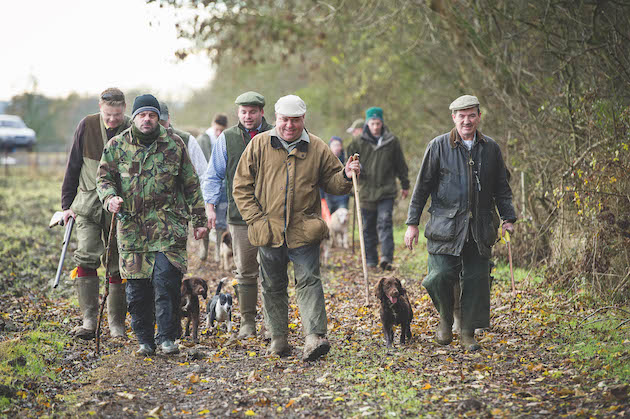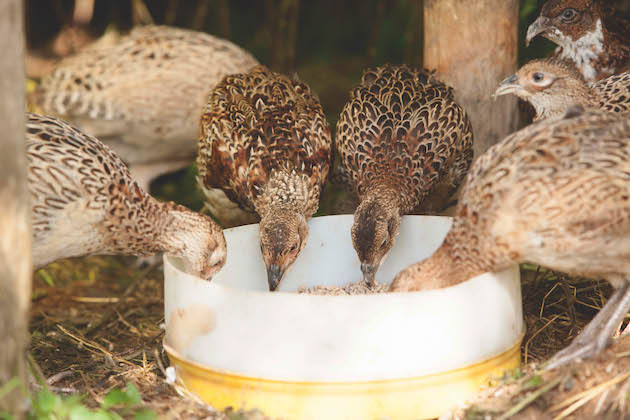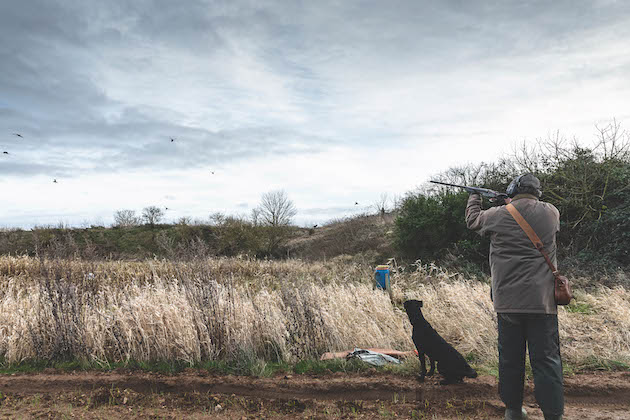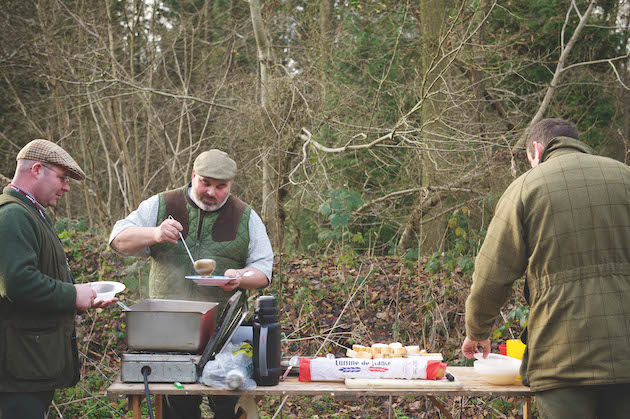Win CENS ProFlex DX5 earplugs worth £1,149 – enter here
Eight key steps for creating a successful shooting syndicate
 Wayne Forkings, Tim Roberts, John Henton
Wayne Forkings, Tim Roberts, John Henton
In 40 years of delivering game management advice, I’ve seen all sorts of shooting syndicates, from big formal shoots to little groups of working people who simply want to escape into the countryside for a few winter Saturdays. Some of these gangs are the happiest of people and others much less so. While I have seen things that work and things that don’t, I cannot say that I believe in a magic formula. However, there are some things that always seem to lead to difficulty and some that help to avoid arguments.
Keep shooting syndicates simple
It goes without saying that you need like-minded people and, in my experience, the more complex the syndicate, the harder it is to make it work. The happiest I have ever known was a three-way arrangement — me, my mate and the owner. We each brought our bit to the party, my mate and I doing the keepering and the owner providing the ground, some bits of cover crop and the wheat to feed the birds. We could then share the sport three ways, each inviting a chum or two to share our days.
As membership increases, so does the scope for squabbles. This is worse still when you move into having half or even quarter guns, with the inevitable complaint from some that they were not involved in any of the bigger days. Regulating the bag to approximately the same number each day to avoid this is tremendously hard and likely to be wasteful.
In the natural order of things, it is much better to accept that you will shoot more on a November day than you are likely to achieve after Christmas. For those reliant on released birds, take note of GWCT research that has shown that you need to release twice as many to shoot a January bird as a November one.

Having clearly defined roles and responsibilities, such as who feeds the poults, can avoid fall-outs
Straightforward rules
A simple set of rules helps too. Number one should be that everyone will abide by the Code of Good Shooting Practice. I would also suggest that every member should become a GWCT-accredited game Shot. This is easy to do online and gives everyone in the syndicate confidence that people know and understand what they are doing.
Please make sure that the rest of the rules are clear and explicit, and read them out at the start of each day by way of reminder. I remember once being consulted by someone who had been drummed out for shooting a fox. The Gun concerned knew that there was a ‘no ground game’ rule, but said that a fox is not game. Well, no it is not. The Ground Game Act (1880) is specifically about rabbits and hares, so best make the rule clear by saying “nothing on the ground” if that is what you mean.

A variety of habitats and contours is a key factor when choosing a patch of ground for a syndicate
The right place
Most of the time, those who are forming a syndicate will have found a patch of ground, but if you are looking for a place, I’d suggest thinking in terms of variety. A place with some woods for pheasants and woodcock, a bit of wetland to attract snipe and duck and a bit of contour to show the odd high bird is ideal.
I would also always ask for agreement that some bits of cover crop are on the cards, not least because this might facilitate adding redlegs. Ideally, you want to be able to site these well to show good sport, not merely accept awkward corners that are hard to farm.
Try to avoid the situation where you are renting the shooting from someone who is not the person who farms the land. Three-way squabbles between shoot, landowner and tenant farmer are common. When the shooting rights and the land are separately owned, this tends to get even worse. Wherever you are, good, friendly communication is key.
A benevolent dictator
The syndicate captain needs to be exactly that. Like the captain of a ship, he or she needs to be in charge, but the crew also need to respect that. The captain needs to hear opinions and weigh them up fairly, but too much democracy is a bad idea.
It may seem unfair to say it, but there are lots of very pleasant Guns out there who really do not know much about the detail of game management. As a result, running a shoot on entirely democratic lines is often a recipe for disaster. On the assumption that there is a keeper employed on the shoot, it is also crucial that they have only one boss. Other syndicate members should be treated with respect, of course, but no one can reasonably take orders from several different people at once.
Professional advice
If a dispute breaks out or things are not really working well, it is wise to get outside advice. As a professional game management adviser with the GWCT, I take pride in the fact that what I offer is good value to the shoot. I’d like to think that the GWCT’s fee for my time is normally more than recovered in value terms in the first season. Many times, I have felt that I could have saved much heartache and expense if I had got there several seasons earlier. Indeed, some of the happiest syndicates I know have become regular clients, factoring a visit into the budget every season or two as good-value fine-tuning.
The foundation of a good syndicate is competent keepering and getting the right person – amateur or professional – can pay dividends for a shoot
What to release
Most low-ground syndicates are based around released pheasants, but redlegs are very much a part of the story, too. Time and again in my advisory role, I am asked about the fact that the return on redlegs is poor. This is usually where the shoot has decided to add a few for variety, without really considering whether they are well suited to the ground.
In my experience, good results with redlegs mostly happen where they are managed in their own right, rather than as a bolt-on to pheasants, where they have a strong habit of escaping out of the side of the drive.
The butcher’s dogs
There was once a shoot in Kent organised and run by a butcher who did the keepering too. When he phoned in December to ask me for advice, he said: “The syndicate are not happy. We have only shot 20% and there are very few birds left.” So, I met him a week later at the shop, where there was a fun handwritten poster in the window proclaiming: “Oven-ready fezants, £2 each.”
I could tell the main thing that was wrong almost straight away. When we arrived at the shoot, he let two spaniels out to hunt ahead of us all the way round, flushing the few birds that we saw. Add in a shortage of hoppers, most of which were empty — “Well, there is no point filling them with no birds to feed” — and you have the classic hunger and disturbance mix to drive the birds away. My man may have been a great retail butcher, but he was no gamekeeper.

Combining a work party with a social event like a barbecue is a good tactic for syndicate harmony
Competent keepering
It follows from the story above that a successful syndicate needs competent keepering, whether this is done by someone specifically employed, a keen volunteer or shared between the syndicate. However, anyone whose heart is not in it is unlikely to get a good result. Some of the finest and most effective keepers that I have met are amateurs and part-timers looking after a small syndicate. Big shoots and professionalism do not always equate.
In most cases, gamekeeping costs are a significant part of the budget and there is naturally a desire to keep these down. Working syndicates, where everyone takes a turn at the chores, are one possible solution, but they are also often prone to disputes, because some believe ‘old so and so’ doesn’t do it properly.
However, cutting costs by having a few work parties can be a good way to get things done. If you add a little clay shooting and a summer barbecue after the work, you can turn these days into a fun social event that folk look forward to. Or you can try to impose work by fining the no-shows £100 and add that to the shoot budget. Overall, I prefer the fun and harmony of the carrot approach.
Related Articles
Get the latest news delivered direct to your door
Subscribe to Shooting Times & Country
Discover the ultimate companion for field sports enthusiasts with Shooting Times & Country Magazine, the UK’s leading weekly publication that has been at the forefront of shooting culture since 1882. Subscribers gain access to expert tips, comprehensive gear reviews, seasonal advice and a vibrant community of like-minded shooters.
Save on shop price when you subscribe with weekly issues featuring in-depth articles on gundog training, exclusive member offers and access to the digital back issue library. A Shooting Times & Country subscription is more than a magazine, don’t just read about the countryside; immerse yourself in its most authoritative and engaging publication.







